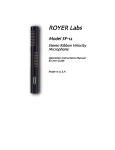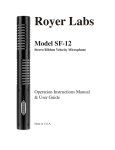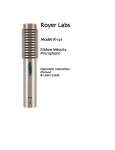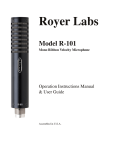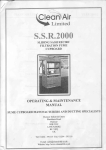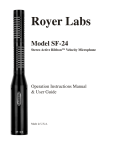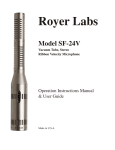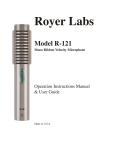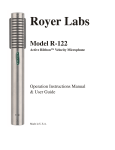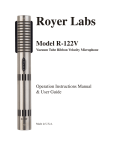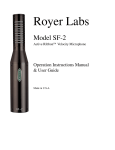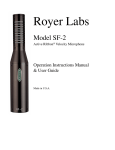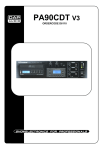Download ROYER Labs Model SF-12 Stereo Ribbon Velocity
Transcript
ROYER Labs Model SF-12 Stereo Ribbon Velocity Microphone Operation Instructions Manual & User Guide Made in U.S.A. TABLE OF CONTENTS Model SF-12 Stereo Ribbon Velocity Microphone Introduction page 2 Description page 2 Users Guide page 3 Amplification Considerations page 4 - Stereo Microphones and Ground Loops page 6 - Equalization and Ribbon Microphones page 7 - Hum, Noise and Mic Orientation page 7 Microphone Technique page 9 Specialized Stereo Recording Techniques: -Classic Blumlein Recording page 12 -Mid-Side (M-S) Recording page 13 Care and Maintenance page 14 Features page 16 Specifications page 16 Wiring Diagram page 18 Frequency Response and Polar Pattern page 18 Notes page 19 Warranty page 20 Introduction Congratulations on your purchase of a Royer Labs model SF-12 ribbon microphone. The SF-12 is a handcrafted, precision instrument capable of delivering superior sound quality and overall high performance. This operator’s manual describes the SF-12, its function and method of use. It also describes the care and maintenance required to ensure proper operation and long service life. The users guide section of this manual offers practical information that is designed to maximize the performance capabilities of this microphone. Royer Labs products are manufactured to the highest industrial standards using only the finest materials obtainable. Your model SF-12 went through extensive quality control checks before leaving the factory. Normal care is all that is required to assure a lifetime of trouble-free service. Please read this manual thoroughly in order to become familiar with all of the SF-12’s capabilities. It will assist you in making the most of its superior acoustic properties. This owner’s manual is a handy reference guide and we suggest you refer to it whenever questions arise on the use and care of your SF-12 ribbon microphone. Description The SF-12 is a compact, stereophonic ribbon microphone array consisting of two matched microphone elements that are placed one above the other. Each transducer is positioned at 45º to the left and right of center, or 90º from each other. When held vertically, connector down and the“ROYER” logo facing the sound source, the upper microphone is the right channel and the lower one is the left channel, from the perspective of an observer behind the mic. The microphone elements are each bi-directional (figure-8) and may be addressed from either side with equal sensitivity. The in-phase signals are achieved when the microphone is addressed from the front, as indicated by the “ROYER” logo. If, however, the microphone is suspended upside down, the connections to the preamplifier should be reversed since what was the left transducer is now responding to signals from the right and vice versa. 2 Your SF-12 is equipped with a 5-pin XLR extension cable and a splitter cable that fans out to twin 3-pin male XLR connectors. As shipped from the factory, the connectors are marked “upper” and “lower” since referring to them as “left” and “right” could lead to confusion. The SF-12 is reasonably tolerant of shock and vibration, but care should be taken to prevent accidental stretching of the ribbon elements. This is covered in the Care & Maintenance section of this manual. The performance of the microphone is unaffected by changes in temperature or humidity. User Guide Using the SF-12 Ribbon Microphone Operation The SF-12 is a versatile device capable of accurate sound reproduction. There are a few important facts about ribbon microphones that are key in understanding how to use them intelligently. 1. The SF-12 is a side-address, bi-directional microphone and the rejection in the ‘dead’ areas is very strong. Due to this directionality, ribbon microphones should be placed at 1.3 times the distance normally used with omni-directional microphones, or about the same distance used for cardioid microphones. This method is used to achieve the same ratio of direct to reflected sound. 2. In the horizontal plane, ribbon microphones do not discriminate against the ‘highs’ off axis, nor do they boost them on axis. Therefore, several instruments or vocalists can be placed in front of the microphone without favoring the performer in the center of the group. Several performers can be grouped at both the front and the back of the microphone, with one proviso; since the outputs are out of phase at the front and back of the microphone, cancellation can result if two tenors are placed on opposite sides at equal distances and are singing in unison. Therefore, listen to the feed before committing to it. 3. The Royer model SF-12 requires no power supply and is safe 3 to use on consoles with phantom microphone powering, provided that the cabling is wire properly. It should be noted that not all ribbon microphones are compatible with phantom-powering systems, so check the manufacturer’s recommendations before using other ribbon microphones. Faulty or improperly wired cables could also cause problems with your SF-12. 4. Never attempt to test the SF-12 or any ribbon microphone with an ohmmeter. A blown ribbon could result. 5. Always provide adequate protection for your SF-12, or any ribbon microphone for that matter. If the microphone is to remain set up on a stand when not in use, place the included mic sock over it until it is to be used. Do not carry the microphone around without placing a mic sock over it. Failure to follow this commonsense practice may yield a stretched ribbon and compromised performance! Amplification Considerations The performance of a ribbon microphone is directly affected by the choice of microphone preamplifier it is paired with. With so many mic preamps on the market, how do you select one that gives the best possible performance with a ribbon microphone? Additionally, what kind of performance can we expect from the preamplifiers built into our mixing desks? While most preamplifiers will handle ribbon microphones well in most recording situations, some preamps that work perfectly well with condenser or dynamic mics may prove to be poor performers with ribbons. To begin with, we must understand the fundamental differences between ribbon microphones and other popular types, namely condenser and moving coil dynamics. A ribbon microphone is actually a dynamic microphone that uses a flat, extremely low mass ribbon element, rather than a coil/diaphragm assembly. For this writing, any mention of “dynamic” microphones will relate to moving coil dynamics. All condenser microphones have a built in preamplifier called a head amp and therefore put out a hefty signal. Because the signal is buffered through the head amp, the output impedance is rather low and less affected by the input impedance of the microphone 4 preamp. Most dynamic (moving coil) microphones generate a healthy enough electrical current to work well with a variety of preamps, and their limited frequency response characteristics make mic loading less of a concern. Ribbon microphones generate a highly accurate signal, but the average ribbon mic generates approximately 20dB less gain than that of condenser microphones. Remember, the ribbon transducer does not have the benefit of a condenser mic’s built in head amp, so a ribbon microphone relies solely on the microphone preamp for all its gain! The so called ideal preamplifier is the proverbial “straight wire with gain.” This may be considered the technological ideal and does not include “coloration” as a desirable feature. However, coloration is often desirable and has given rise to the popularity of certain preamps and even preamp stages in mixing desks. Neve® preamps and the famous Trident® A Range mixing console are highly praised for their classic sound. So what should we use with our beloved ribbon microphones? The features that translate into top performance for a ribbon microphone are the following: 1. Lots of gain! A ribbon microphone works best with preamplifiers that have at least 60-70 dB of maximum gain. 2. Low noise is a must! With this much gain being required for efficient operation of a ribbon microphone, the noise characteristics of the preamp play a pivotal role in overall performance of the captured acoustic event. 3. Load characteristics: A suitable preamplifier should have input characteristics that impose the least amount of loading to the ribbon element. In other words, the input impedance should be high enough that its effect on the performance of the mic is negligible. A good rule of thumb is to have a preamplifier with input impedance at least five times the impedance of the microphone. For example, if the mic is rated at 300 Ohms (as Royer’s are), the preamp should have an input-impedance of at least 1500 Ohms. If the impedance of the preamp is too low, the microphone will lose low end and body. 5 4. Transparency: A good preamp should sound natural with no edginess. Tube preamps sound warm, yet wonderfully transparent. Transformer coupled preamps sound punchy. When recording with condenser or dynamic microphones, engineers often choose mic preamps that help warm up the mic, but warming up the signal does not need to be a consideration with ribbon mics because they are by nature warm and realistic sounding. Stereo Microphones and Ground Loops Some preamplifiers are prone to developing ground loops when used in conjunction with stereo or multi channeled microphones such as the SF-12. Ground loops can develop in the preamplifier with any stereo microphone, regardless of the type (i.e. condenser, dynamic, ribbon). A ground loop manifests itself as unwanted buzz or hum at 60 Hz and/or harmonics of 60 Hz. The condition is brought on when the left and right transducer elements are plugged into two inputs of a stereo or multi-channel preamplifier. The two three-pin male XLR connectors on the SF-12’s splitter cable share Pin-1 as ground, so they are grounded to each other through the cable set. If the grounding scheme within the preamplifier is poorly designed, or the distances to internal ground are too great, a ground loop develops. The problem may be more apparent with ribbon microphones because of the high gain required for proper operation. You can perform a simple test to check for this condition (preferably done with a pair of headphones to avoid feedback). Plug one side of the stereo microphone into either preamplifier input. Listen to the output of the preamp. All should be quiet except for the mic signal. Now plug the second side into the next preamplifier input. If a noise or buzz develops, you have a ground loop. The ground loop may be very slight or more pronounced, depending on the preamp. Battery powered preamps usually do not exhibit this problem, and neither do well designed, line operated mic preamps. The simple fix is to disconnect one of the microphone’s two Pin-1 ground connections. A better method is to make a small ground lifter out of a male-female XLR barrel adapter. Switchcraft makes a very nice one and it takes less than five minutes to wire it up. Simply connect Pin-2 to Pin-2, Pin3 to Pin-3, and leave Pin-1 disconnected. Correcting the problem at the preamplifier would be preferable, but is often more difficult and/or expensive. 6 In conclusion, try to find the best preamp you can afford that hasgood gain characteristics and low noise. Coloration is optional. Equalization and Ribbon Microphones One of the great strengths of ribbon microphones is how well they take EQ. Even with substantial amounts of equalization, ribbons retain their natural, “real” quality. For example, when a lead vocal is being performed on a ribbon microphone, you can actually boost the upper end frequencies to the point where the ribbon mic emulates the performance curve of a condenser mic with excellent results. This is not to say that a ribbon microphone can replace a quality condenser mic, but the EQ friendliness inherent in ribbon microphones does allow for an enormous amount of flexibility. The reason that ribbon mics take EQ so well is their inherent low self-noise, unusually smooth frequency response characteristics and freedom from off-axis coloration. Dialing in high amounts of equalization on condenser or dynamic microphones also means dialing in extra amounts of the microphone’s distortion products and self noise; garbage that contributes to an unnatural, unpleasant sound. Because distortion and self-noise are almost non-existent in ribbon microphones, high levels of EQ can be used without adding harshness or excessive noise. Hum, Noise and Mic Orientation All dynamic microphones, including ribbons, are susceptible to picking up stray alternating magnetic fields. Power transformers (such as those found in guitar amplifiers) and alternating current motors are the most likely sources of hum. Building wiring and electrical utility transformers are other likely sources. A welldesigned microphone provides shielding to minimize the effects of stray magnetic radiation. In some cases complete isolation is impossible and the result is usually hum or buzz. Ribbon microphones can potentially manifest this condition to a greater degree because of their higher gain requirements. With vintage ribbon microphones that employ large, bulky magnet structures, the problem can be worse. Royer SF-1 and SF-12 microphones are designed to minimize the effects of unwanted radiation by integrating the transducer barrel as part of the magnetic return circuit. With this design, the barrel that houses the transducer serves to complete the North-South magnetic return and neutralizes the effects of outside magnetic radiation. The SF-1 mono and 7 SF-12 stereo ribbon microphones go one step further by incorporating toroid impedance matching transformers, which have a natural ability to repel magnetic radiation. Dynamic and ribbon microphones are passive devices, meaning they incorporate no external or internal power supplies and have no head amplifier and therefore cannot produce hum on their own. Unwanted noise (hum and buzz) can only come from an external source. Repositioning a dynamic or ribbon microphone is the easiest way to identify and eliminate unwanted noise. If hum is detected, it means that the microphone is in the proximity of an alternating magnetic field. While listening (preferably with headphones) to the mic, move it around. The mic will find the noise source quite easily. If you are miking a guitar amplifier and suspect the amplifier’s power transformer may be the source of unwanted noise, move the mic around the amp. You will probably find that the noise is louder as you approach the amplifier’s power supply and quieter when you move it away. Eliminating the noise can be fairly simple and requires using the ‘null’ point of the microphone. The null point is the position where the microphone’s pick-up of stray magnetic radiation is at its lowest. Slightly rotating the microphone is usually all that is required to cancel out the noise. This is similar to the procedure guitarists use to eliminate noise from single coil guitar pickups. There will be a position where the noise is greatly reduced or disappears completely. 8 Microphone Technique General Tips for Using the Royer SF-12 The following are good basic starting places for recording with the SF-12. These positions are known to produce good results, but experimentation is the key to getting the most out of your recordings! Photographs of many of the following techniques can be found on our website, www.royerlabs.com It is important to remember that the SF-12’s ribbon elements can be damaged by wind. When the SF-12 is mounted on a boom stand, be sure the stand is moved slowly. When the microphone is taken down, put it in its box immediately or, if it is to remain in its shock mount, place the mic sock over the ribbon end of the microphone. Leaving the microphone out unprotected is inviting a re-ribbon. Ensemble Performances The SF-12 records ensemble performances beautifully. Simply find the point in the room where you hear the best blend of the instruments and room sound and place the microphone there, with its logo facing the performers. Strings For stereo recordings of stringed instruments, start by positioning the microphone a few feet off the body of the instrument. Depending on the acoustics of the room, you may want to move the microphone closer to or further from the instrument to add or minimize ambience. For violin, position the SF-24 horizontally, two or more feet above the instrument. For larger string sections, try placing the microphone slightly above the instrumentalists and angled down; a distance of three or four feet willdo the job nicely. 9 Drum Overhead & Room Position the SF-12 horizontally over the center point of the kit, two to three feet above the cymbals. For a centered snare drum, aim the Royer logo at the snare. Adjusting the height of the SF-12 by even 6-inch increments will produce dramatic variations in how the cymbals sit with the rest of the kit. Many times an overhead SF-12 is all that is needed for tom-toms and cymbals. For a single point stereo room mic, position the SF-12 vertically at four to eight feet in front of the kit. Compress to taste for either a very natural drum sound (light compression) or large rock drum sound (heavy compression). For jazz recordings, EQ is generally not required. For more aggressive drum tracks where cymbals need to sizzle, you can brighten them by adding a few dB of 10K to 12K. Brass Brass records beautifully with ribbon microphones. For an overall picture of a brass section within a larger recording session, try placing the microphone two to three feet above the instrumentalists and angled down, at a distance of three to eight feet from the section. For a solo trumpet, position the SF-12 vertically at a height of four to eight feet and anywhere from five to 20 or more feet from the section. Close miking brass is a job for the Royer R-121, R-122, or R-122V - we do not recommend close-miking with the SF-12. Reed Instruments Normal working distances are about a foot or two from a solo reed instrument. For multiple instruments, try placing the microphone slightly above the instrumentalists and angled down, at a distance of two to four feet. Piano There are several positions that will give excellent results with the piano. Start with a distance of one foot to several feet from the bend of the piano. A more direct, up front sound will be 10 achieved when the microphone is placed closer to the soundboard. If it is possible to remove the piano lid, an SF-12 suspended horizontally over the soundboard will give outstanding results. If the room sounds good, try positioning the mic 10 to 20 feet from the piano for more room ambience. If you position the SF-12 under the open lid of the piano, there will be some amount of reflected sound from the lid. Careful positioning can minimize or accentuate lid reflections, depending on what sound you’re striving for. Choir and Orchestra An SF-12 can produce dramatically good recordings of an orchestra or choir. If possible, position the SF-12 at approximately ten feet high and a few feet behind the conductor. The wide stereo pickup will reproduce the orchestra or choir with a stunning you-are-there realism. The rear lobes of the figure-8 elements bring the ambient qualities of the recording environment into the recording, adding to the natural feel of the recorded performance. Percussion The SF-12 records percussion instruments naturally, without upper frequency hype or low-end boominess. Congas, bongos and the like can be recorded with left/right stereo effect by positioning the mic within a few feet of the instruments. Shakers, bells, triangles and other instruments that are often problematic in the upper frequencies will record naturally and unabrasively. Vocal with Acoustic Guitar For recording a vocal with acoustic guitar, two separate mono tracks are required with little leakage between the tracks. One stand and one SF-12 can do the job nicely when the two axes of sensitivity are correctly oriented (see illustration). Note: The SF-12 is not recommended for closemiking loud amplified instruments. Its sensitive ribbon elements were not designed for extremely high SPL applications like close-miked electric guitar. For close-miking high SPL sound sources, ruggedness is a 11 must and we recommend using our R-121, R-122, or R-122V ribbon microphones. Specialized Stereo Recording Techniques Classic Blumlein Technique For many years, “coincident” microphone setups have been widely used for picking up sounds in stereo as naturally as possible. The “Blumlein” technique, named for A.D. Blumlein, involves the use of two figure-eight microphones positioned as in the sketch (see Figure 1); one mic faces left and the other faces right, at an angle of 90º (i.e., each displaced 45º from center). Each microphone ultimately feeds one speaker in a stereo system and, due to the directionality of the microphones, the result is a very well defined stereo image on playback. For classical music particularly, the reproduction can be very satisfying. Figure 1 The SF-12 stereo microphone is two identical ribbon microphones in just this Blumlein orientation: if the microphone is placed in front of the performance, with the Royer logo facing the center of the ensemble to be recorded, the microphone will give a stereo recording as per the Blumlein technique. Because of the togetherness of the SF-12’s ribbon transducers, sound will arrive at both ribbon elements at the same time. This means that the two channels can be summed to mono with no comb filter effects, and room reverberation (undesirable in mono) is cancelled to a surprising degree. For the sake of clarity, engineers commonly refer to similar stereo miking with cardioid mics as “X-Y.” When figure-8’s are used, it is more commonly referred to as “Blumlein” recording. 12 Mid-Side (M-S) Technique In the early days of stereo radio broadcasting, the Mid-Side recording technique was developed to allow for 1) simultaneous stereo and mono feeds from the same mic array and 2) electronic manipulation of the width of the stereo image. In M-S recording, one mic faces sideways, one faces forward as shown in Figure 2, and they are connected as shown in Figure 3. With the SF-12's logo facing the center of the performance, the mic is positioned for X-Y recording. Rotating the SF-12 counter-clockwise by 45º positions it for M-S recording. With the SF-12 in a vertical position, cable end down, the upper ribbon element faces the Figure 2 center of the performance and is the ‘mid’ microphone, and the lower ribbon element is at 90º to the performance and is the ‘side’ microphone. If the microphone is to be mounted upside down, make the proper adjustments in your wiring orientation. If the outputs of the mid and side elements are made equal using gain controls, the stereo pickup will be similar to that of two microphones placed as a Blumlein X-Y pair, delivering a wide stereo image. As you reduce the level of the side element, the width of the stereo image will narrow until, with the side element turned all the way down, you have just the “mid” element panned center and giving a mono pickup. If the outputs of the mid and side elements are recorded on separate tracks, the electrical connections shown in Figure 3 can be made at the mixer outputs and the adjustment of the stereo separation can be done during mixdown, rather than during the actual recording. Space does not permit a fuller discussion of the M-S intensity stereo format, first described by Alan D. Blumlein over 50 13 years ago. We suggest the following reading on the subject: W. Dooley & R. Streicher “M-S Stereo: A Powerful Technique for Working in Stereo” J. Audio Eng. Soc., Vol. 30 pp.707 (1982 Oct.) Figure 3 Care and Maintenance The SF-12 is a solidly built, precision instrument. All that is required to ensure proper operation of this microphone is to follow some commonsense rules. 1. To avoid transducer damage, do not expose the microphone to severe shock or vibration. If the microphone is accidentally dropped, test it to see if damage has occurred before returning it to service. Low output or a dull sound would indicate a stretched ribbon. 2. Do not expose the microphone to direct blasts of air or strong air currents. Use a windscreen or suitable blast filter when close miking a vocalist or certain types of wind instruments. P-popping does not necessarily damage the ribbon element but may produce unacceptable preamplifier overload and could cause damage to speaker systems. 3. Do not expose the microphone to liquids or caustic smoke. 4. Do not expose the microphone to strong alternating electromagnetic fields, i.e. the power transformers in amplifiers, 14 or a hum may result. 5. Use a soft cloth to clean the microphone body. A small amount of denatured alcohol can be used to remove fingerprints and other stains. 6. Keep metal filings away from the microphone at all times. The SF-12's powerful magnets can attract minute ferris particules into the ribbon transducers, compromising the performance. 7. When not in use, store the microphone in its protective carrying case. If the microphone is to remain set up on a mic stand between sessions, cover it with its mic sock (provided with your SF-12). 8. Leave disassembly of the microphone to a trained technician. There are no user-serviceable parts inside. Caution: Do not check the SF-12 with an ohmmeter or continuity tester, and do not connect the unit to an input device designed to power a capacitor microphone. Strong winds and mechanical shocks should be avoided. Care for the Optical Black Finish The SF-12's optical black finish is a sophisticated surface treatment designed to refract light rather than reflect it. This makes the microphone appear less conspicuous, especially when used with high intensity lighting or within a camera shot. The finish requires occasional maintenance to retain a smooth, even appearance and to maintain its unique optical qualities. The SF12's body is comprised of a low carbon steel alloy. Its finish consists of black chrome deposited over a nickel substrate, creating a finish that minimizes the reflective nature of the metal surface. A small amount of oil has been worked into the finish at the factory to protect it. Over time, some of this oil will be drawn out due to "wicking" action; the physical handling of the microphone, absorbent materials it is exposed to (like the foam padding of the microphone case), etc. As the oils are drawn out of the microscopic surface layer, the microphone finish may develop an uneven appearance. If this happens, simply massage the microphone gently with a lint free cloth treated with a few drops of light machine oil or WD-40® (apply the 15 oil to the cloth, not to the microphone). Be very careful whenever working around the transducers to avoid contamination of the ribbon elements. Following this simple procedure will protect the finish and renew it to its original luster. CAUTION! Due to the transducer’s powerful magnets, keep recorded tapes, spring-wound watches and personal credit cards with magnetic coding away from the microphone to prevent possible damage. Features and Specifications SF-12 Features: • • • • • • Wide, Smooth Frequency Range Closely Matched Characteristics Negligible Off-Axis Coloration Excellent Separation and Imaging True Figure-8 Polar Patterns X-Y or M-S Recording SF-12 Specifications Acoustic Operating Principle: Electrodynamic pressure gradient Polar Pattern: Symmetrical Figure-8 Generating Element: Two 1.8 micron aluminum ribbons Frequency Response: 30Hz - 15000Hz ±3dB Sensitivity: > -52dBv Re.1v/pa Output Impedance: 300 Ohms @ 1 kHz Recommended Load Impedance: > 1500 Ohms Maximum SPL: > 130dB 16 Output Connector: male XLR 5 pin (stereo) Dimensions: 206mm L x 25mm W (8” L x 1” W) Weight: 369 grams (13 oz.) Finish: Matte Black Chrome, Dull Satin Nickel (optional) Accessories: Protective wood case, one (1) 18’ shielded 5 conductor cable with 5-pin connectors, adaptor cable terminating in two (2) XLR type 3-pin male connectors, mic clip, mic sock Optional Accessories: Shock mount, WS-12 blast filter Microphone Warranty: Lifetime to original owner (repair or replace at Royer’s option) Ribbon Element Warranty: One Year For up-to-the-minute information on Royer products and their usage, visit our website at www.royerlabs.com 17 Wiring Diagram Polar Pattern Upper Element Lower Element Frequency Response +10 +5 0 -5 -10 20 50 100 500 1000 18 5K 10K 15K 20K Notes: 19 Warranty Royer Labs warrants the SF-12 to be free from defects in materials or imperfect workmanship. This lifetime warranty is offered to the original owner and is not transferable. Royer Labs will repair or replace an SF-12 that fails to meet factory specifications during the warranty period (ribbon elements excluded). No other warranties are implied. To validate this warranty, product registration and proof of purchase must be on file with Royer Labs. This warranty does not apply if the product has been damaged by accident or misuse, or as a result of repair or modification by other than a Royer Labs customer service facility authorized to service this product. Should it ever become necessary to service your SF-12, please contact the factory for a return authorization number and packaging instructions. In our continuing effort to improve our products, Royer Labs reserves the right to make improvements without notice or obligation. Specifications are subject to change without notice or obligation. Serial Number_____________________________ Upper Sensitivity________Resonance__________ Lower Sensitivity________Resonance__________ Date of Purchase___________________________ ROYER Labs 2711 Empire Ave. Burbank, CA 91504 Telephone: 818-847-0121 Fax: 818-847-0122 20





















